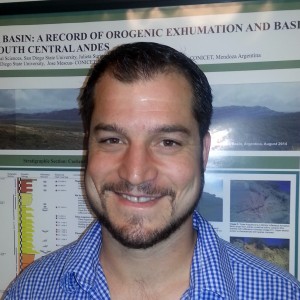 Clay Mineral Analysis of a Mudstone Facies: Jurassic Curtis Formation, East-central UtahRobert Connor Thursday, May 7th, 2015 |
||
|
||
| ABSTRACT The Curtis Formation, a lithostratigraphic unit of the San Rafael Group of east-central Utah, was deposited mainly by tidal currents in a nearshore shelf depositional system during Late Jurassic time. In the lowermost 6 to 8 meters (20 to 26 feet) of the Curtis lies a mudstone facies, for which an analysis for composition and origin of clay minerals has not been done. A week was spent systemically collecting samples at four locations. Three are along the western San Rafael Swell (Sid and Charley, Horn Silver Gulch, and South Sand Bench), and one is on the east side of the Swell (San Rafael Swell East). Samples were collected at half meter intervals from just above the J-3 regional unconformity on the underlying Entrada Sandstone up to where the facies became silty and sandy. Because the samples are cemented with calcium carbonate, they were disaggregated with acetic acid to yield an insoluble of silt and less than 2 µm (0.002 mm) clay-sized particles. Silt grains separated from clay grains sediment in a settling tube two hour period. The clay-liquid sediment was drawn with a syphon tube, smeared on glass slides, and allowed to dry. Each of the clay smears was then further prepared for four different analysis on the x-ray diffractometer: 1) untreated, 2) glycolated with ethylene glycol, 3) heat treated to 4000 C, and 4) heat treated to 550o C. Clay minerals found include smectite, illite, and chlorite. Their presence suggest an origin likely formed by hydrolysis of orthoclase, plagioclase, biotite, and muscovite minerals from a felsic to intermediate parent rock. Alternatively, conditions during burial diagenesis may explain the origin of these clay minerals. Based on the calculated thickness of the overlying Jurassic, Cretaceous, and Cenozoic rocks at nearby Bryce Canyon, the maximum burial depth is estimated at 2,678 m (8,786 ft) with a maximum burial temperature of 120.5o C. For the clay mineral assemblage revealed in this study to have formed by burial diagenesis is unlikely because the geothermal gradient is probably closer to the median value (35◦C/Km) rather than the maximum value (45◦C/Km). Furthermore, the actual thickness of overlying layers could be less than 2,678 m because the Curtis Formation today is exposed at ground level at each sample location. A comparison of the diffractometer traces of samples from the base to the top of the mudstone facies shows the proportion of illite decreasing and the proportion of smectite increasing stratigraphically upward. Further study is needed to determine exact origin of the clay minerals and if this upward stratigraphic change in the proportions of illite and smectite might be related to changes in depositional conditions. |

